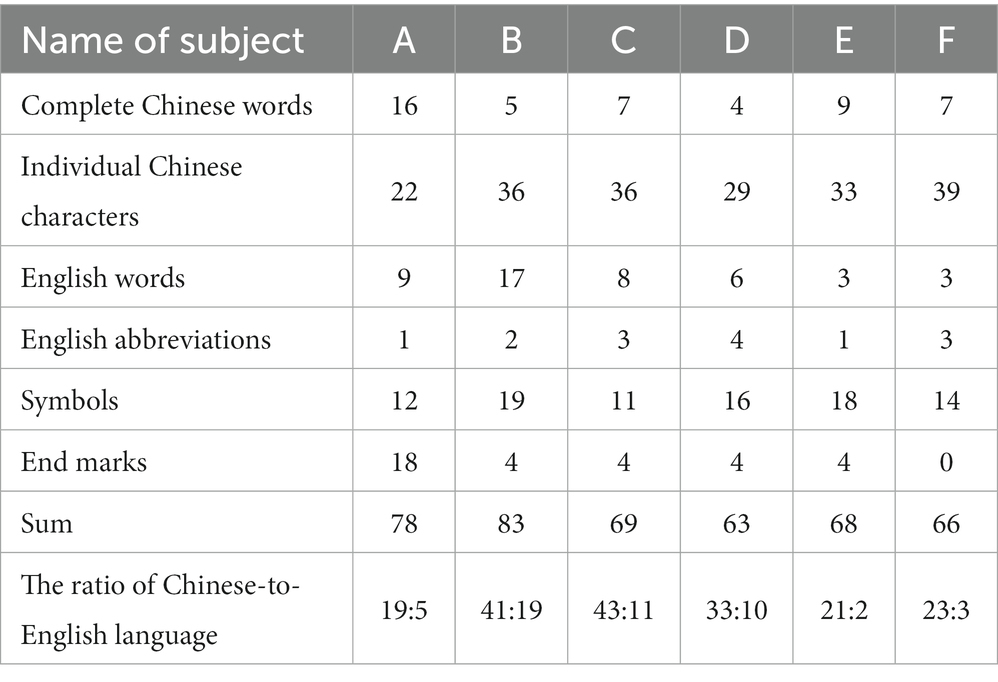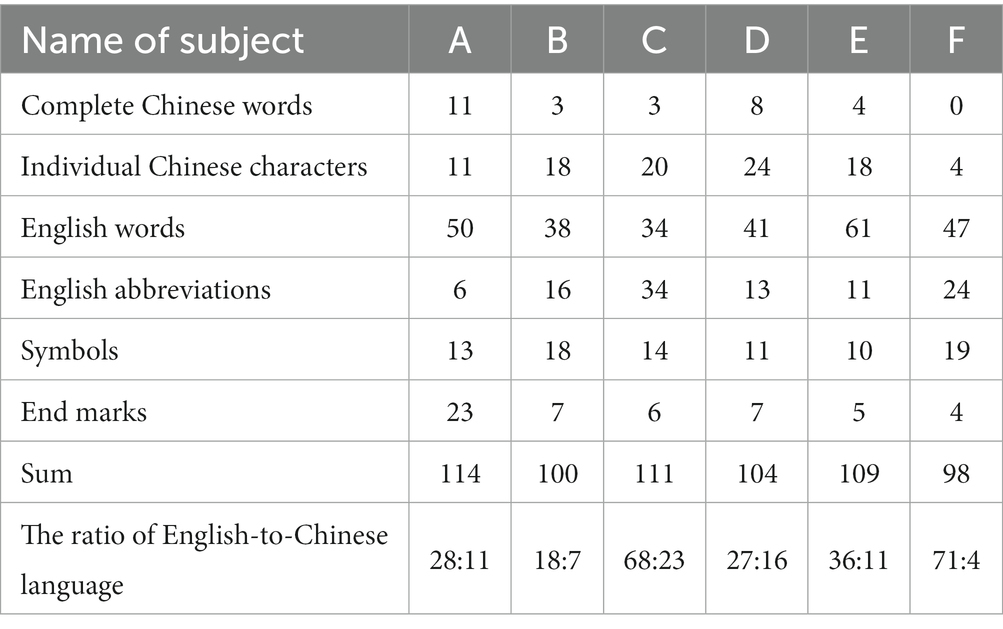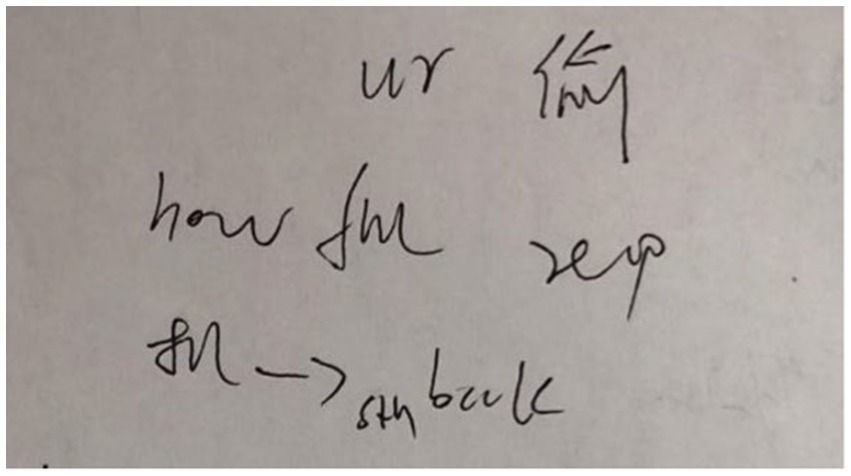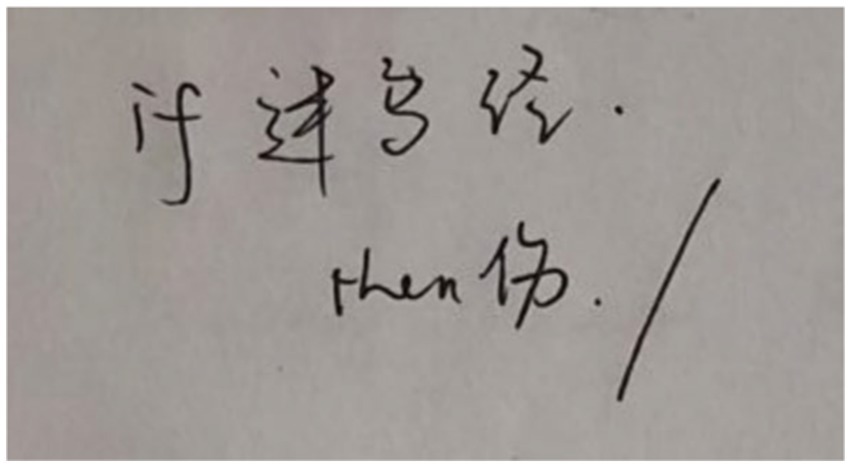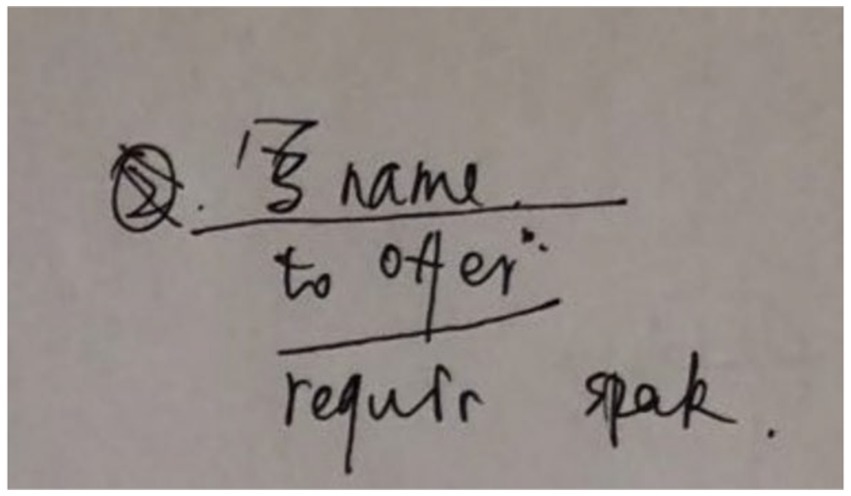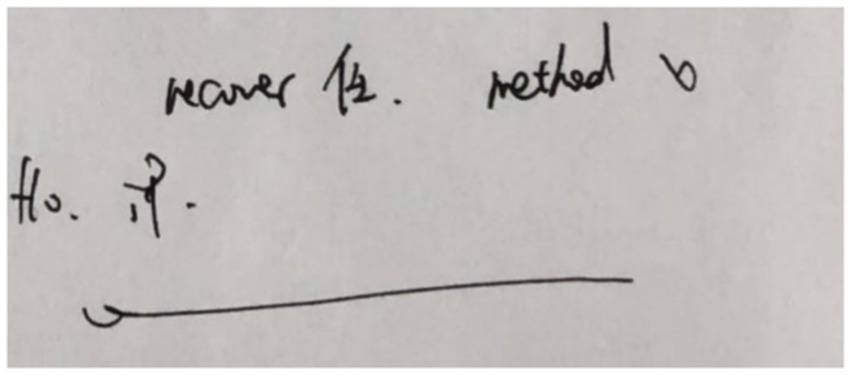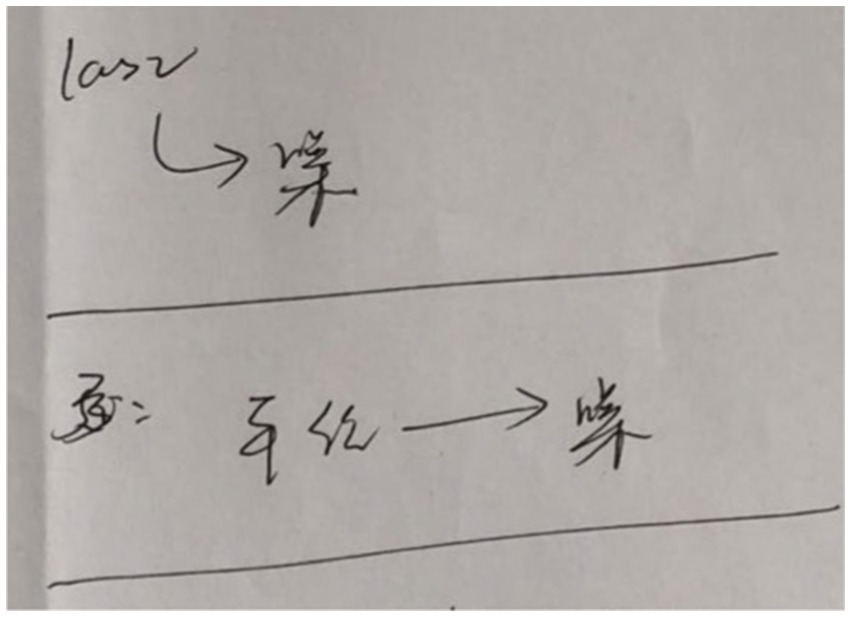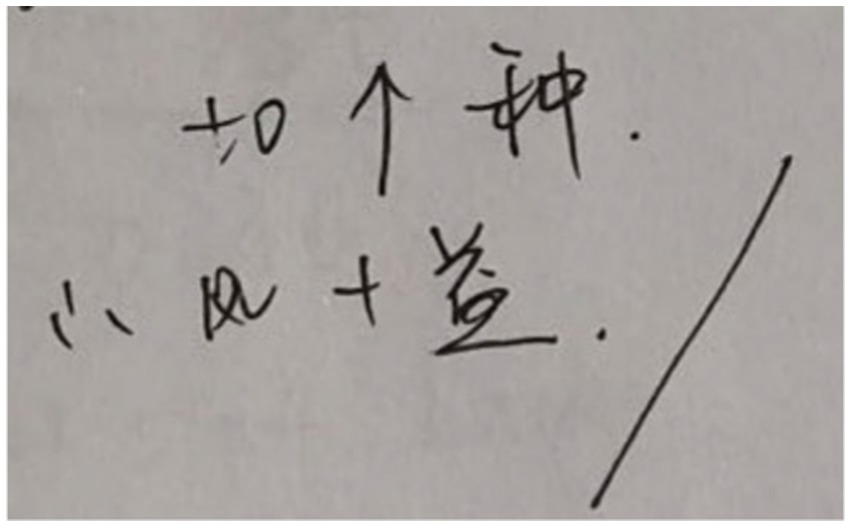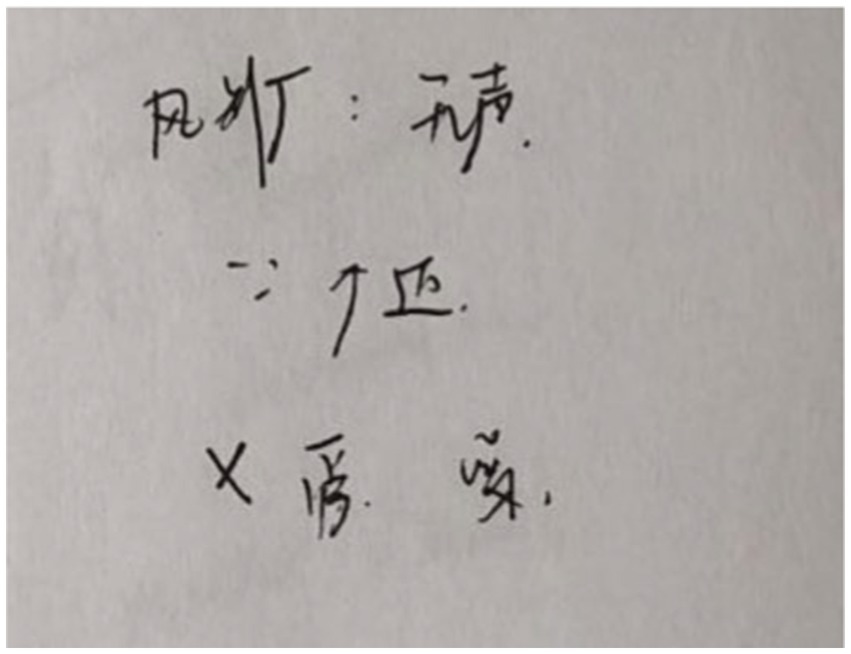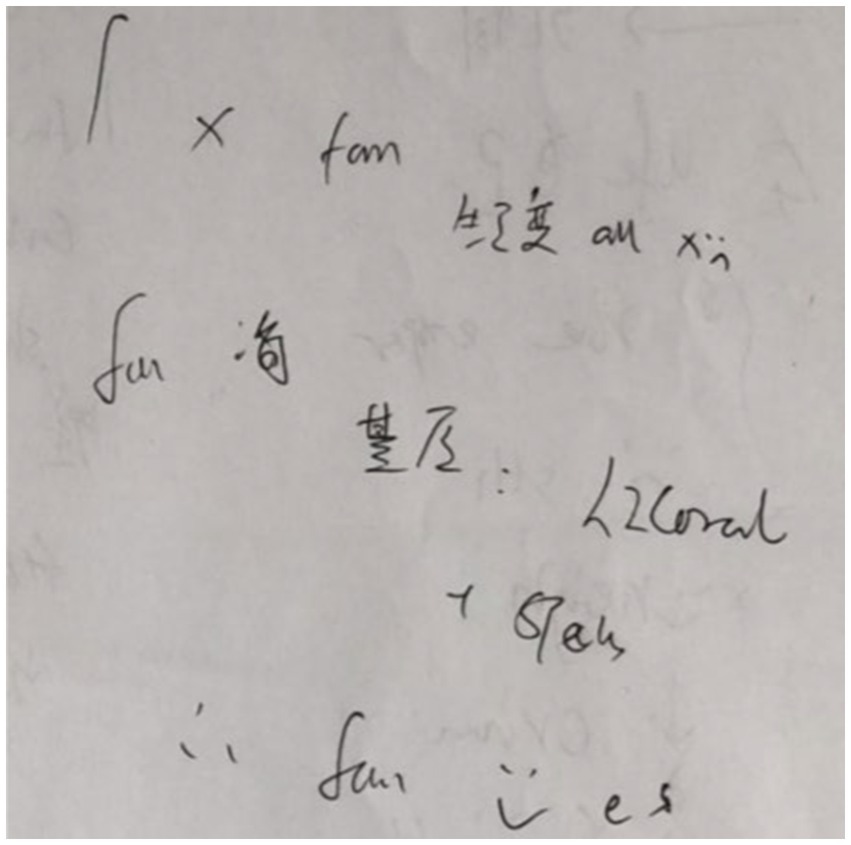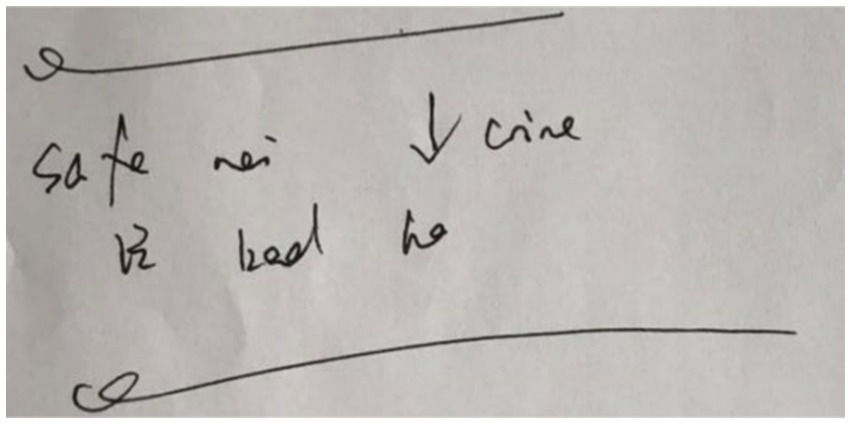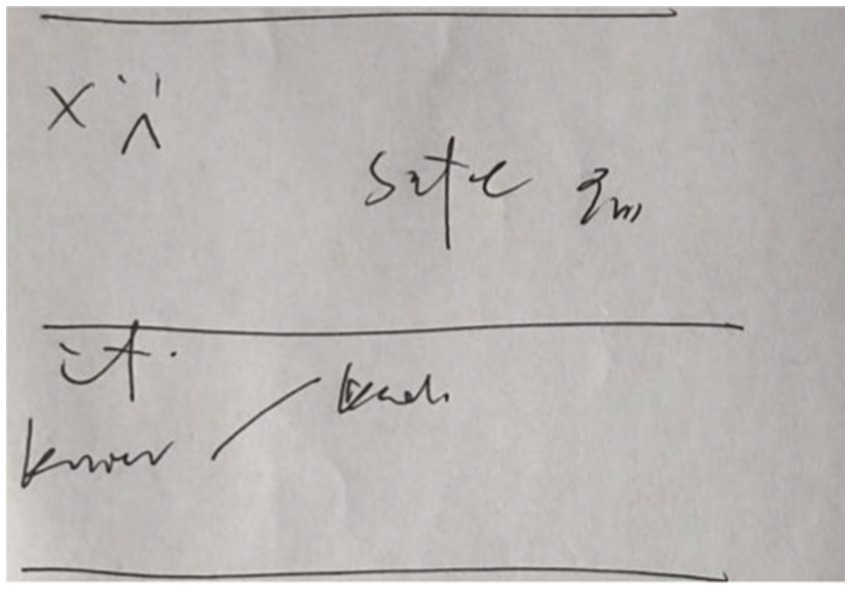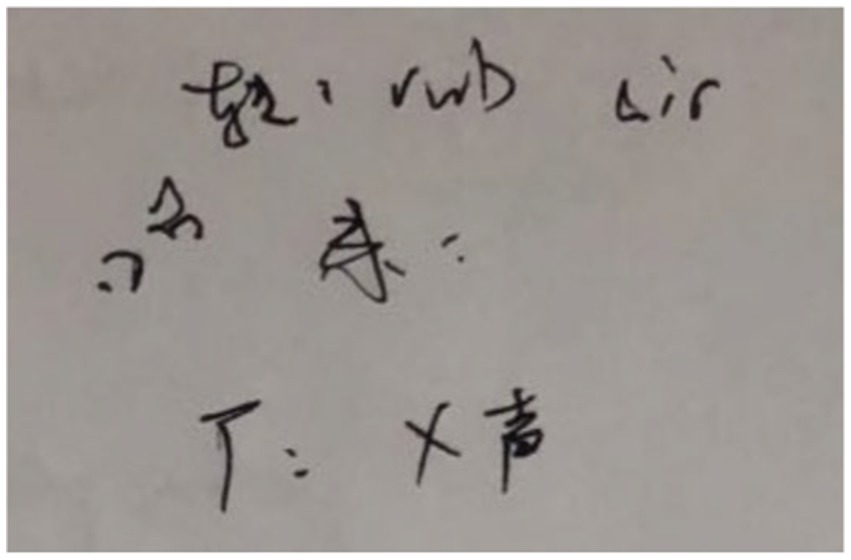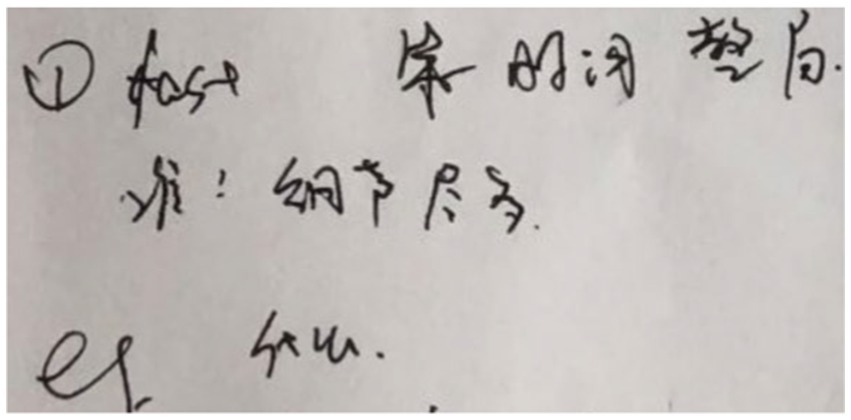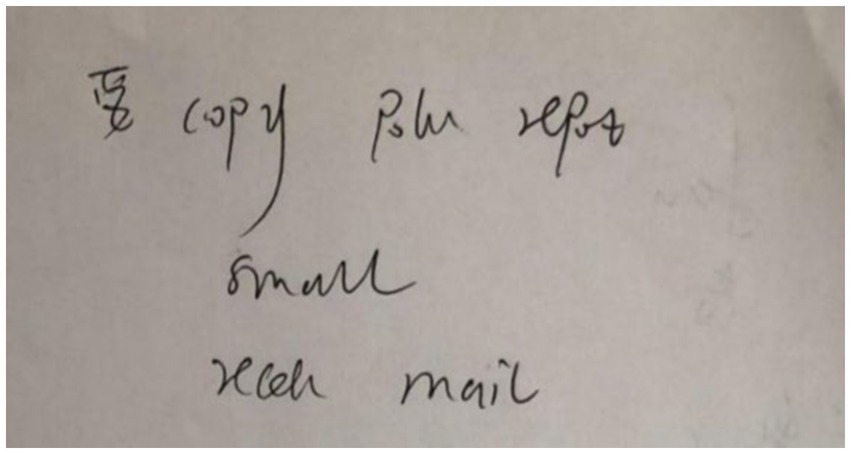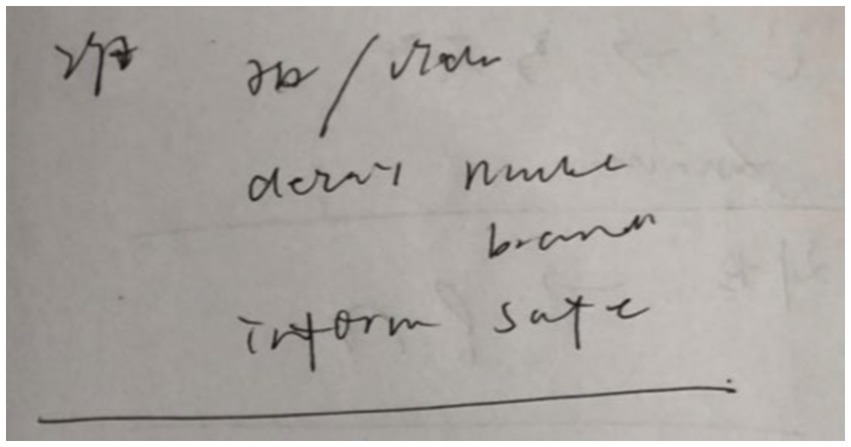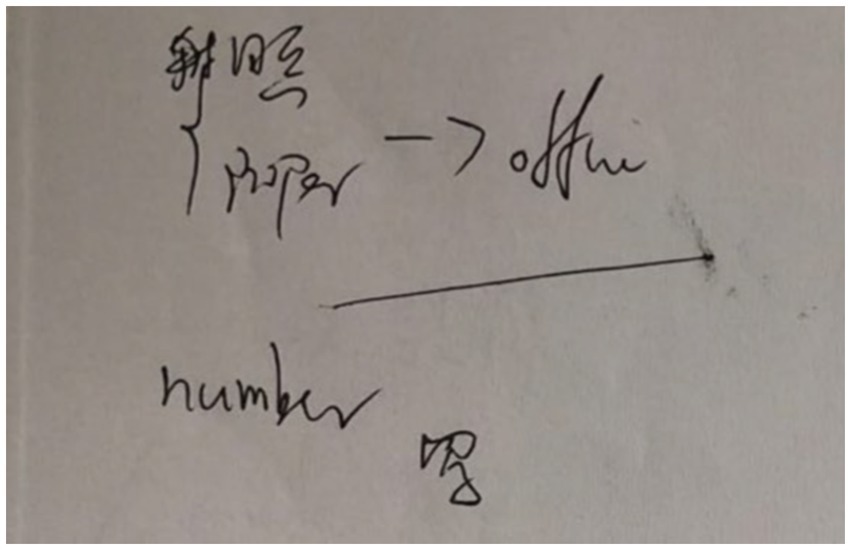- School of Foreign Languages, Dalian Maritime University, Dalian, China
This paper aims to explore the relationship between note-taking and interpreting quality in consecutive interpreting. Research questions focus on three perspectives: language choice, the use of symbols and their influence on interpreting quality, and the problems in note-taking. The research design is divided into three steps: pre-interpretation preparation, consecutive interpretation, and retrospective interview. Through the empirical study, a mixed research method is adopted with the analysis of the notes and retrospective interviews with six participants whose major is translation and interpreting at a university in Northeast China. Specifically, both descriptive data analysis and correlation analysis are used for quantitative data, and thematic analysis aims to better describe qualitative data. Findings are as follows: first, students prefer to use English to take notes in English-to-Chinese consecutive interpreting, while Chinese is used more in Chinese-to-English consecutive interpreting; second, the number of symbols used is not related to the quality of interpreting; third, the following five problems are identified from the interview with student participants in students’ notes: missing key information, inconsistent abbreviations, unclear logics, incomplete records of figures and the meaning of figures, and inadequate records of high-density information. The identification of language choice and problems of note-taking in interpreting practice might help teachers and students understand the problems of students’ note-taking and shed light on teaching and learning consecutive interpreting.
1. Introduction
Note-taking is a prompted record of the interpreter’s impromptu and rapid process of managing the cues of the logic of the source language and marking the content, organization, and keywords (Gillies, 2017). The note is a kind of memory aid for interpreters, and it becomes an important carrier of the interpreting content throughout the process, prompting interpreters to convert the original auditory symbols into visual symbols (Jabaghyan, 2021). Therefore, the strength of note-taking ability is directly related to the accuracy of interpretation.
Compared to Western countries, the Chinese interpretation program is unique in terms of development history and learners (Su, 2021). First, the history of interpretation courses in China is relatively short. In contrast to Geneva, where the first senior translation institute was founded in 1941 (Chilingaryan et al., 2016), China did not launch an interpreter training program at Beijing Foreign Studies University until 1979. As a result, China lacks sufficient experience in creating interpretation courses and refining interpretation techniques. Second, in terms of the surrounding language, as the dominant language in China becoming Mandarin, students can only practice bilingual or multilingual skills, especially translation and interpreting in colleges and universities. All of these factors motivate the author to contribute to interpreting research in China, hoping to provide some insights for current interpreting learning.
Dam (2004) stated that the choice of language in interpreters’ note-taking was mainly governed by the status of the language in the interpreters’ language combination, and much less by its status in the interpreting task. In order to seek evidence for or against the proposal, Szabó (2006) conducted a small-scale empirical study focusing on the language of note-taking in consecutive interpreting and revealed that interpreters with Hungarian as their A language and English B had a strong tendency to take notes in English, irrespective of the direction of interpreting, which did not fully support Dam’s finding. Few pieces of research were conducted in terms of the language choice in English-Chinese consecutive interpretation. While in consideration of the importance of symbols used in interpreting, Wang et al. (2010) analyzed the notes taken by 12 college English majors and found there was no significant correlation between the features of note-taking and the quality of interpretation. Differently, Chen (2022) conducted a quantitative study from the perspective of social semiotics to present the differences between trainee interpreters and professional interpreters. However, there are seldom studies that can be found designed for postgraduates majoring in translation and interpreting when searching on the Google Scholar website. Students agree that note-taking is a major difficulty in their study and interpretation practice, with great essence for the improvement of students’ interpretation (Maydosz and Raver, 2010). Therefore, it is a great necessity to study language choice, symbol use, and note problems for graduate students majoring in translation and interpreting.
The study aims to answer three research questions:
I. What is students’ language choice in note-taking for consecutive interpreting?
II. What is the influence of symbol use on the quality of consecutive interpreting?
III. What are the problems with the notes that affect the quality of consecutive interpreting?
The author conducted an empirical study with mixed methods, using both qualitative and quantitative research methods, particularly the analysis of the notes and interviews with six graduate students majoring in translation and interpreting at a university in Northeast China. The study is believed to benefit students and teachers. For students majoring in translation and interpreting, the study of their note-taking can help to summarize the common mistakes in note-taking and interpreting practice, helping to inform students how to improve their note-taking process and interpreting ability. For teachers, as the interpreting classes have been developed for a relatively short period of time in China, the teaching quality is relatively weak compared to other subjects. Studying the choices of language during note-taking and how the note-taking process can support interpretation and student perceptions of the problems in note-taking can help to strengthen the knowledge of students’ interpretation ability, clarify the teaching orientation, and then develop a more effective teaching plan.
2. Literature review
2.1. Previous research on the relationship between note-taking and interpretation
Rozan (1956) first proposed the note-taking system in 1956 with great influence across the world. Then, many books and articles on note-taking were published followed by Rozan, generating a wilder impact on the research area. Meanwhile, works of literature written about note-taking in consecutive interpreting boomed (e.g., Wang et al., 2013; Wang and Guo, 2015; Liu and Xu, 2017). In the beginning, experienced scholars aimed to provide suggestions and guidelines for interpreting through an introspective view of note-taking and discussion from different aspects as Matyssek (1989) proposed a system mainly based on symbols, and Rozan (1956) chose to use language-dependent elements.
However, a variety of themes concerning empirical research were later done (e.g., Dai and Xu, 2007; Liu, 2010; Chen, 2022). And many scholars conducted empirical studies from different aspects and attempted to find certain interactions between note-taking and interpreting quality. In order to investigate the form of notes, Marani and Heidari Tabrizi (2017) studied the process of note-taking in Persian-English consecutive interpreting, five Iranian interpreters were interviewed and observed. The findings imply that interpreters without passing courses take notes based on their experiences irregularly rather than the rules and principles. Compared to Liu (2010)’s study, whose student participants were English majors, investigating the form of note-taking and finding that the high-score group used more symbols and clear-separation marks than those in the low-score group.
In terms of the choice and language, which sparked mounting concerns in note-taking literature (e.g., Gao, 2019), some literature suggested taking source language as a priority. It was believed that interpreters could “minimize their effort and save capacity” (Szabó, 2006, p. 131) during the phase of listening under great time pressure. For example, Hanusiak (2021) analyzed which language was preferred by students in note-taking whose mother tongue was Polish when interpreting English into Polish through a regular consecutive task, presenting that the source language was adopted primarily. However, writing the target language in notes was recommended by others because they argued it could make production much less effortful and facilitate better processing of interpretation. To hold critical thinking, González (2012) suggested that the expertise level in consecutive interpreting is the relevant factor in the language choice for interpreters.
The relationship between note-taking and interpreting performance triggered scholars’ interest although there is no consistent conclusion. Orlando (2010, 2014) tried to find clear ways of evaluating the progressive acquisition of note-taking systems through digital pen technology. Based on suggestions that the accuracy of target text can be judged by examining the semantic network, Dam et al. (2005) developed assumptions regarding the characteristics of efficiency and non-efficiency in notes. Dam (2007) evaluated the hypothesis later from five qualified interpreters who translated from Spanish to Danish. The data showed evidence for the hypotheses, “the more notes, the better the target text–and vice versa,” and “the more abbreviations/the fewer full words, the better the target text–and vice versa” (Dam 2007, p. 194). However, the findings of the research conducted by Cardoen (2013) are contradictory with Dam’s conclusions, which showed that fluent chunks contained fewer notes, more full words, and fewer abbreviations than disfluent chunks. The fact that Dam chose professional translators while other researchers took students as participants may help to explain why her findings were not replicated (Chen, 2017).
Through this brief review of previous research on note-taking in consecutive interpreting, we are able to find that major inconsistencies still exist despite some detected general trends, such as the use of language overweight that of symbols during note-taking. Most of the empirical studies’ data is based on undergraduate students (whose interpreting abilities differ a lot), and some reviews concerning listening comprehension during interpreter training (e.g., Cerezo Herrero, 2017). It is detected that few scholars conduct research on postgraduate students majoring in translation and interpreting with the aim of figuring out the relationship between note-taking and interpreting quality. As postgraduate students play an increasingly important role in translation and interpreting education, the research aims to explore the relationship between masters’ note-taking and interpreting quality in China (Man et al., 2020).
2.2. Theoretical framework
Gile (1995/2009) proposed the Effort Models (EMs), which focused on how interpreters allocate their energy to tasks such as listening, comprehension, memory, and output during the process of interpreting, and the effort model includes the Interpreting Model of Simultaneous Interpreting and the Interpreting Model of Consecutive Interpreting, and the Interpreting Model of Comprehension (Shao, 2013). In this paper, as the research focus is consecutive interpreting, we only discuss his Model of Consecutive Interpreting. The model of consecutive interpreting suggests that interpreting can be divided into two phases. The first one is listening and note-taking, which can be expressed as Interpreting = L + N + M + C (L means Listening and Analysis, N means Note-taking, M means Short-term Memory operations, and C means Coordination. The second phase is Target-speech production, which can be expressed as CI = Rem + Read+P (Rem means Remembering, Read means Note-reading, and P means Production).
In the first phase, the effort required for listening and analysis refers to the time it takes for interpreters to hear the source language, take notes, and produce the interpretation, and the short-term memory in this phrase is negatively related to the duration of the speaking. The main difference between the two phrases of memorization is that the second one refers to the constant recall of information units from a speech by relying on long-term memory On the face of it, the second phase seems more tedious and complex than the first, but if the notes are recorded properly, they can be a good aid to the interpreter’s memory and make the interpretation of the notes easier (Gile and Chai, 2009).
In the first phase of Gile’s model, Interpreting = L + N + M + C, if the interpreter is able to use symbols appropriately, it will greatly reduce the effort required for the N (Note-taking) part. At this phase, to balance the distribution of attention required between N and L, it is necessary to make effective notes during listening. Only when the efficiency of notes is improved and the content of notes is targeted, can more energy be allocated to M to active short memory. In the second phase, the use of symbols also makes it easier for interpreters to interpret the content of the notes and reduces the effort spent on reading. Thus, according to Gile’s theory, the use of symbols in consecutive interpreting notes reduces the amount of attention ad energy allocated by the interpreter to N, M, Rem, and Read, thus better ensuring the quality of output.
Many scholars have conducted their studies by using the Effort Models. For example, Wu and Wang (2009) proposed a supplementary solution named discourse transformation to tide over the capacity gap based on the Gile’s Effort Models. While, Gumul (2018) found empirical evidence for Gile’s Effort Models by triangulating retrospective protocols with product analysis with 120 interpreters, clearly supporting Gile’s observations about the nature of the interpreting process. To better explain the implication of the didactic construct, Gile (2021) conceived EMs as a functional didactic tool to implicate high cognitive load, analyze fundamental issues, and predict future evolution in translation and interpreting, shedding light on the frontier field.
3. Methodology
The study was conducted with six postgraduate students majoring in translation and interpreting at a university in China. Three steps were contained in this empirical study, pre-interpretation preparation, consecutive interpretation, and retrospective interviews. Throughout the study, a mixed research method was adopted. The analysis of notes was used to better represent language choice and symbol usage, and retrospective interviews with participants aimed to figure out problems in note-taking. Both quantitative data and qualitative data have been collected and analyzed, the former concerned with descriptive data analysis and correlation analysis designed for the first two research questions, while the latter contained thematic analysis for the last question.
3.1. Participants
Six participants from the School of Foreign Languages of a university in Northeast China were recruited. They were all first-year postgraduates majoring in translation and interpreting and passed the postgraduate interpreting assessment with no more than a five difference in marks. All six subjects have passed the same level of the China Accreditation Test for Translators and Interpreters (CATTI). Before the research, they had received semester-long training in basic interpretation courses, being familiar with consecutive interpreting notes and basic skills. Sim et al. (2018) suggested that for qualitative research, diversified recommendations range from 5 to 35 for grounded theory studies, and those for single-case studies from 4 to 30 subjects are feasible to help figure out. Concerning the limitation on the number of masters in translation and interpreting in the university and the effectiveness of data analysis, the author selected 6 participants in this study. The above prerequisites ensure that the subjects have comparable interpretation capabilities and reduce the impact of their capabilities on the results.
3.2. Research design
The research was conducted in a dedicated interpretation classroom, with the audio played by the teacher and the author’s assistance. The empirical process was divided into three steps: pre-interpretation preparation, consecutive interpretation (including note-taking process and interpretation), and retrospective interview. The audio recording was used in consecutive interpretation and retrospective interviews.
3.2.1. Pre-interpretation preparation
Before interpretation, the author gave each subject three blank A4 sheets of paper for writing notes. The author promised the subjects that the records of interpretation and retrospective interviews would be kept confidential and that all notes would be used in an anonymous form for the study so that privacy would not be compromised.
3.2.2. Consecutive interpretation
The author did not inform each subject of the purposes of the research, expecting each student to take notes according to their usual personal habits, thus avoiding the irrelevant factors influencing the results.
Before recording, the teacher tested the headphones and microphones of each subject and ensured the study environment was good. Subjects were informed of the topic of materials before starting, and the teacher was responsible for playing the prepared materials which are one Chinese-to-English audio and one English-to-Chinese audio. The length of the Chinese-to-English audio was 2 min and 15 s, with a speech rate of 244 words per minute, and the topic was the disadvantages of wind power. The English-to-Chinese audio was 4 min and 10 s long, with a speech speed of 109 words per minute, and the topic was how to file a police report for stolen property. Both audios were colloquial and speakers were accent-free, without jargon, and easy to understand.
Then the teacher required students to translate the materials from Chinese to English and subsequently translate from English to Chinese. There were four sections for the Chinese-English translation and six sections for translation from English to Chinese.
Subjects took notes when playing the materials and translated what they had just heard after a pause. After the completion of consecutive interpretations, the author copied six subjects’ recordings to a personal USB and collected all the notes. After the data collection, the audio recordings of their translation were transcribed into text, while participants’ notes were analyzed by counting their use of complete Chinese words, individual Chinese characters, English words, English abbreviations, symbols, and end marks as categorized by Dam (2004) and Liu (2010).
1. Complete Chinese words: forms of Chinese note-taking including phrases and four-character idioms, regardless of whether the strokes are complete or not.
2. Individual Chinese characters: complete or nearly complete Chinese characters occurring alone and containing Chinese radicals.
3. English words: including nouns in singular and plural forms and verbs in different tenses, whether or not spelled correctly.
4. English abbreviations: taking only their first few letters, consonants, and other word parts; initials (e.g., names of institutions, technical terms); default idiomatic abbreviations.
5. Symbols: non-linguistic forms of note including indicative symbols, graphic symbols, interdisciplinary symbols, and combinations of symbols.
6. End marks: marks to distinguish between utterances.
Considering some participants’ poor hand-writing which may make no sense to researchers, therefore, the author confirmed the ambiguous contents with subjects in order to improve the accuracy of the statistics,
3.2.3. Retrospective interviews
After the completion of consecutive interpreting, the researcher conducted retrospective interviews with each of the six subjects for about 30 min. The interviews were audio recorded, and the questions included how the participants chose language when making notes, and whether there is any relationship between note-taking and their perceived interpreting quality. During the interview, the researcher pointed out each participant’s misinterpretation and the words that were not interpreted. Thus, the interviewee could recall the process of making notes and the reason why they made mistakes when interpreting.
3.3. Data analysis
As discussed before, the study intends to collect both quantitative and qualitative data via conducting consecutive interpretations and retrospective interviews. Thus, various methods for data analysis were employed. Before the data analysis, it was crucial to determine participant quality of interpretation, thus enabling the author to figure out the relationship between note-taking and interpreting quality.
With an aim to evaluate the relationship between note-taking and the quality of interpretation, it is important to justify how researchers can determine the quality of interpretation. Many scholars (e.g., Viezzi, 1993; Barik, 1994; Gile 1995/2009) have put forward their own criteria for assessing the quality of interpretation. For example, Kurz (1989) put forward that interpreters should keep a sense of consistency with the original message, while Gile (1991) believed that interpreters should have a faithful image of the original content. As this research focuses on the relationship between note-taking and interpreting quality, scores are provided based on the accuracy of interpretation and complete conveying of key information. On this very note, the author adopts the criteria proposed by Cai (2003): the quality of interpretation is evaluated according to the number of information units interpreted. The information units in this study refer to the definition of the meaning unit in the Interpretivist Theory, semantic units are taken to be information units in a complete hierarchy of meaning, such as the cause in causality, time, or place in narrative structure (See Appendix I). Thus, the author intended to conduct statistical calculations to see the quantification of the interpreting quality.
To analyze quantitative data to answer the first two questions, the researcher adopted descriptive data analysis and correlation analysis. Specifically, the author used descriptive data analysis to present each participant’s note form and information units, while the analysis of correlation was designed to solve the second research question, describing the relationship between different forms of note-taking and interpreting quality by using SPSS software.
To better analyze qualitative data, which helps to answer the third research question, thematic analysis was adopted in this area, including the following steps (Braun and Clarke, 2006). First, the researcher transcribed the verbal data into written forms to get familiar with the qualitative data. Then, the researcher read the transcription several times to make initial codes after which the researcher compared and merged the initial codes. Thus, the themes that can answer my research questions can be found. After the thematic analysis, the themes that relate to my research questions are missing key information, inconsistent abbreviations, unclear logic, incomplete records of figures and the meaning of figures, and inadequate records of high-density information.
4. Findings
The author conducted a quantitative and qualitative analysis of the interpretation and interview data, including quantitative statistics on the form of notes taken by each subject, quantitative statistics on the performance of interpreters, and explored the relationship between the two through SPSS software, as well as providing insights into the findings.
4.1. Quantitative statistics in the form of notes
This research draws on Dam (2004), Dai and Xu (2007), and Liu (2010), classifying the forms of notes into complete Chinese words (e.g., “运行,” “来源,” “人工”), individual Chinese characters (e.g., “叶,” “撞,” “廴”), English words (e.g., point and points, take, took and taken), English abbreviations (e.g., inf for information, IMF for International Monetary Fund, LA for Los Angels, ad for advertisement), symbols, end marks (e.g., horizontal line, diagonal, double horizontal line).
In order to facilitate the comparison between the form of notes and the quality of interpretation, the author counted each subject’s usage of each type of note form as follows.
According to Table 1, the use of Chinese was much more than the use of English when students make Chinese-to-English interpretation notes, with the most frequent notes being individual Chinese characters, followed by the application of symbols. English abbreviations were the least used. The frequency of using complete Chinese words was similar to that of English words, five out of six students had the habit of marking end marks in order to divide utterances, especially when the teacher played a pause in materials.
According to Table 2, the use of English was much more than the use of Chinese when students took English-to-Chinese interpretation notes, where English words most frequently occurred, the complete Chinese words were least used, and the frequency of using individual Chinese characters and English abbreviations was similar. Compared with the process of making Chinese-English translations, all six students had the habit of making end marks when making English-Chinese translations.
4.2. Quantitative statistics on the quality of interpretation
For the assessment of interpreting quality, the author mainly adopted quantitative analysis. In the research, the Chinese-to-English interpretation consisted of 4 paragraphs, in which the author found 45 information units (Table 3) and the English-to-Chinese interpretation consisted of 6 paragraphs, in which the author found 54 information units (Table 4). Please see Appendix I for details.
4.3. Assessment of subject’s interpreting quality
The score was 100 out of 100. Proportionally, each information unit in Chinese-to-English interpretation is 2.22, and each information unit in English-to-Chinese interpretation is 1.85. For students who had not interpreted the complete information accurately, they would get a score of 0. The number of information points that each participant interpreted and the final score of each subject are summarized in Tables 5, 6, please see Appendix II for details.
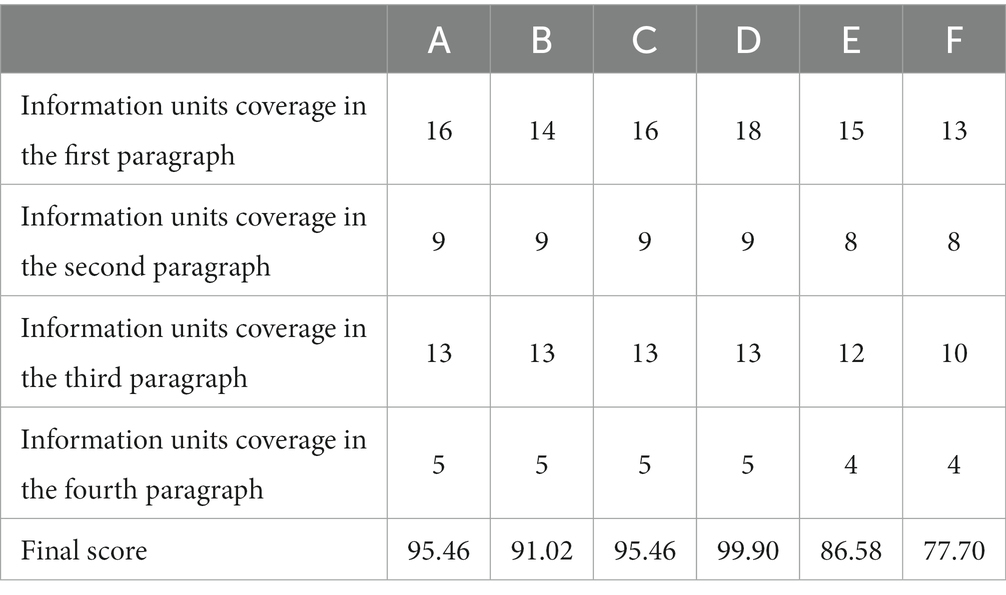
Table 5. Coverage of information units in Chinese-to-English consecutive interpretation by each subject.
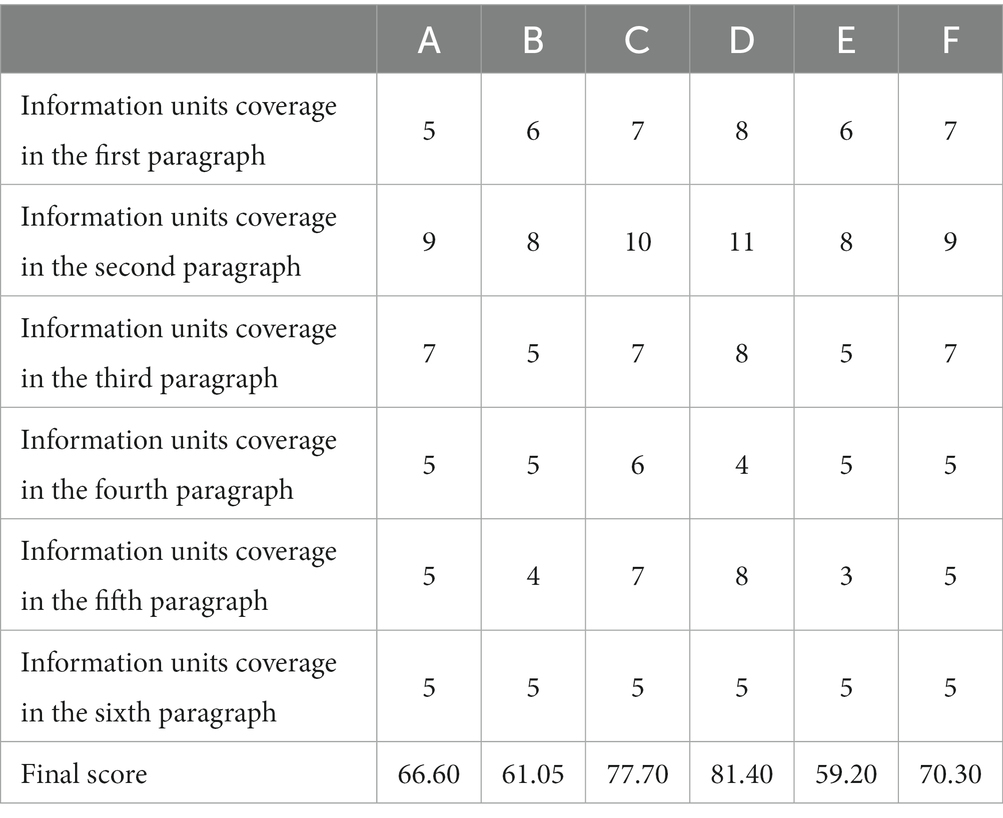
Table 6. Coverage of information units in English-to-Chinese consecutive interpretation by each subject.
4.4. The relationship between note-taking and interpreting quality
To further investigate the relationship between note-taking and interpreting quality, the author used SPSS statistical software to calculate the Pearson correlation between the number of symbols, the proportion of recorded languages, the total number of notes, and the quality of interpretation, respectively. The detailed results were as follows.
Using the Pearson correlation coefficient to investigate the strength of the correlation between the quality of Chinese-to-English interpretation and the number of symbols, the data in Table 7 shows that the correlation coefficient between the quality of interpretation and the number of note symbols is −0.173, which is close to 0, and the value of p is 0.743 > 0.05, thus there is no correlation between the quality of interpretation and the number of symbols (Zhang and Xu, 2009).
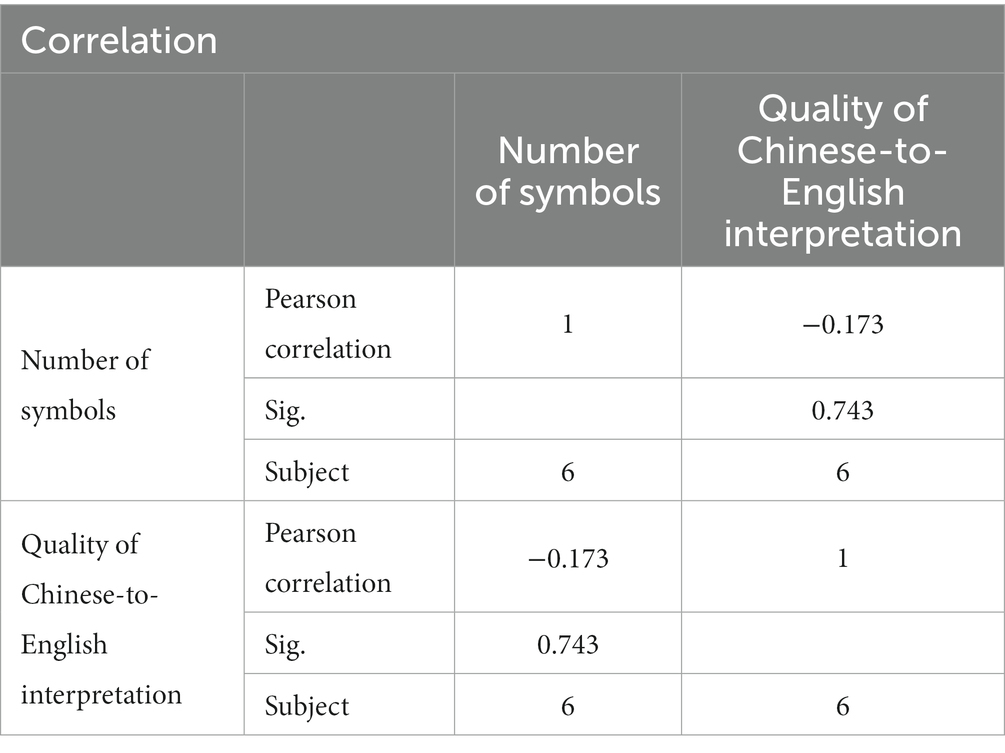
Table 7. The correlation between the quality of Chinese-to-English interpretation and the number of symbols.
Using the Pearson correlation coefficient to indicate the strength of the correlation between the quality of Chinese-to-English interpretation and the total number of notes, the analysis of Table 8 shows that the correlation coefficient between the quality of Chinese-to-English interpretation and the total number of notes is 0.102, which is close to 0, and the value of p is 0.848 > 0.05, thus indicating that there is no correlation between the quality of Chinese-to-English interpretation and the total number of notes.
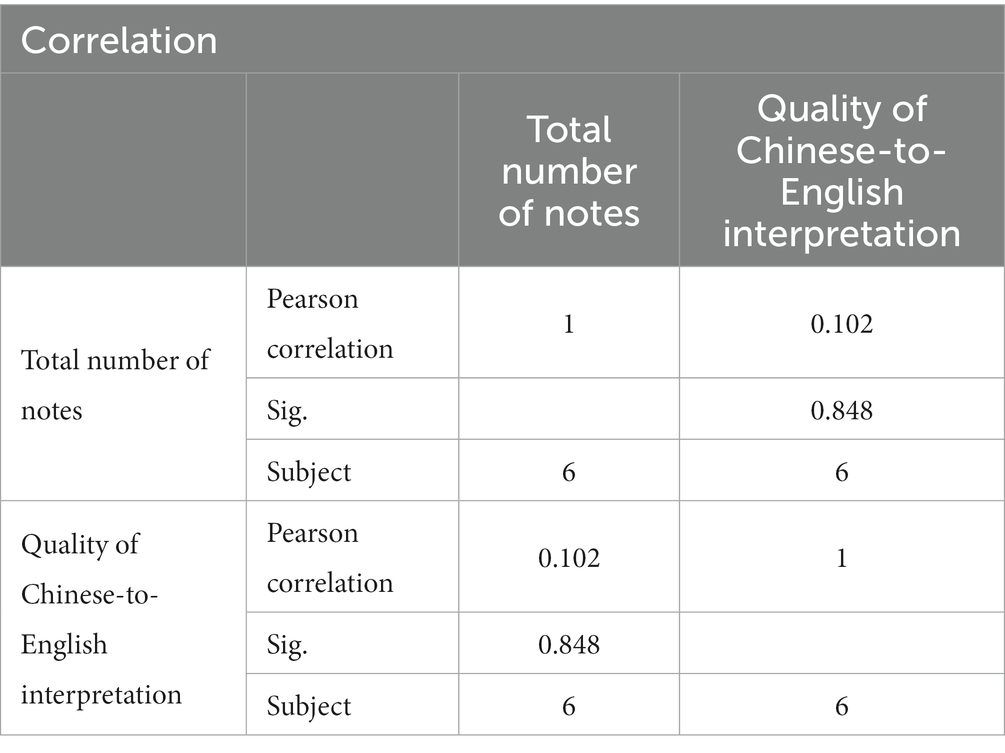
Table 8. The correlation between the quality of Chinese-to-English interpretation and the total number of notes.
The Pearson correlation coefficient between the quality of English-to-Chinese interpretation and the number of symbols is −0.072, which is close to 0, and the value of p is 0.891 > 0.05, thus there is no correlation between the two (Table 9).
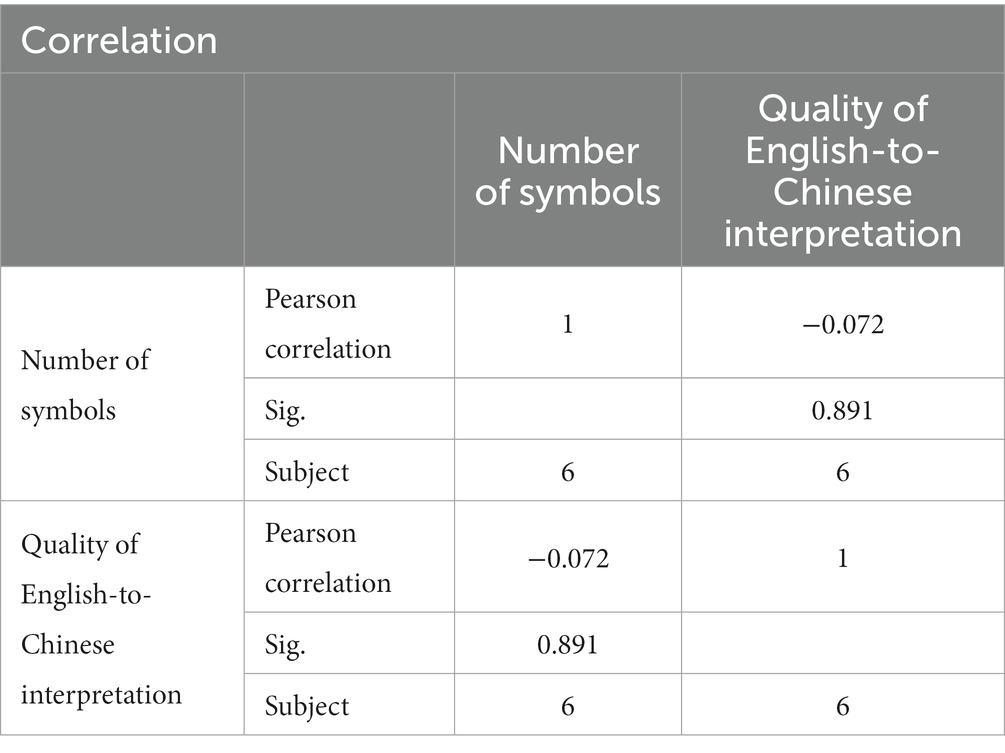
Table 9. The correlation between the quality of English-to-Chinese interpretation and the number of symbols.
From Table 10, the correlation coefficient value between the quality of English-to-Chinese interpretation and the total number of notes is −0.161, which is close to 0, and the value of p is 0.760 > 0.05, thus indicating that there is no correlation between the quality of English-to-Chinese interpretation and the total number of notes.
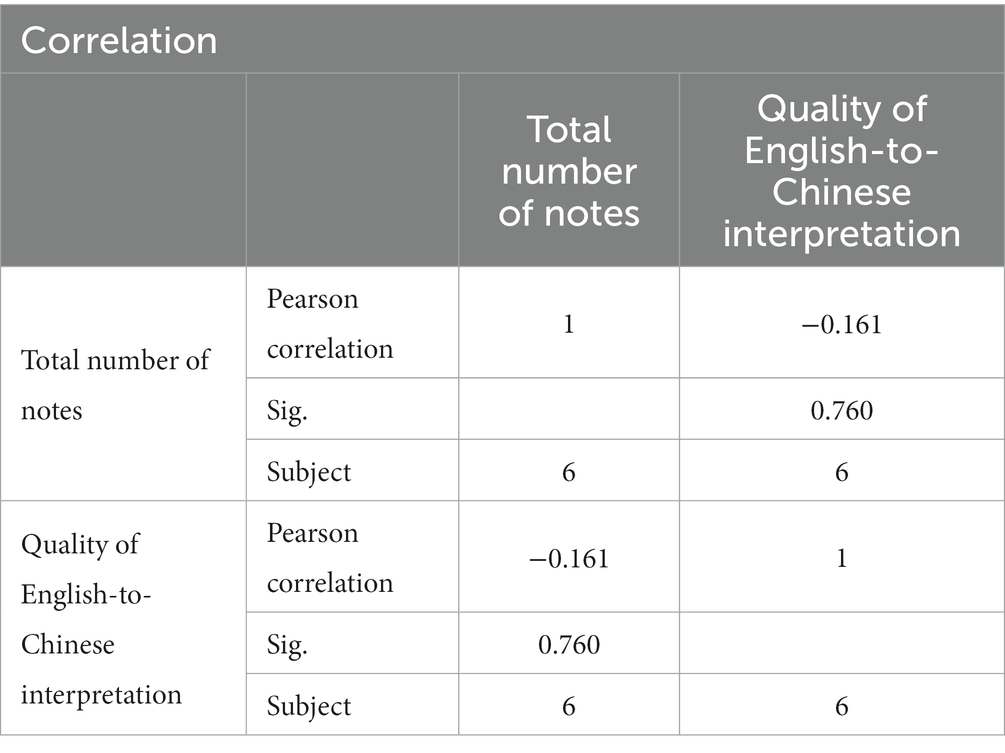
Table 10. The correlation between the quality of English-to-Chinese interpretation and the number of notes.
From a statistical point of view, although there was no significant correlation between the number of symbols and the quality of interpretation, all subjects affirmed the use of symbols and believed that effective usage could reduce memory load, save recording time and improve note-taking effectiveness (Jabaghyan, 2021).
4.5. Problems with note-taking
Note-taking is an important aid to consecutive interpretation, affecting the quality of the interpretation to a certain extent (Dam, 2021). By comparing the materials with the translation transcriptions of each subject and integrating the retrospective interviews, the author found that the factors affecting interpreting quality were divided into two main categories: note-related factors and non-note-related factors.
Based on the retrospective interviews with each subject, the author will focus on the problems related to note-taking, which have been categorized into five situations, namely, missing key information, inconsistent abbreviations, unclear logic, incomplete records of figures and the meaning of figures, and inadequate records of high-density information.
4.5.1. Missing key information
1a. Here’s how to file an accurate police report that increases the chances of getting your stuff back.
1b. 而如何向警方提交一个报告,这是一个非常好的机会,因为它有可能帮你寻回你丢失的物品。.
Subject B said that he understood the word “increase” when the recording was played but did not write it down in notes, resulting in a blurred memory when translating, so he interpreted it as “it was a good opportunity” (Figure 1).
1c. 那么说如果我们要把风机建设在那些候鸟迁徙的必经之路上,很有可能就会对候鸟本身造成一定伤害。.
1d. And it will also hurt the birds and we would probably do harm to the bird itself.
Subject E’s notes were not clear enough, only using the “if” in his notes to determine that there was a causal relationship here, but the key information after “if” was not clearly recorded, resulting in the omission of the interpretation “build the wind turbine on the route of migratory birds” (Figure 2).
1e. You can write down the name of the officer you are speaking with and request that an officer be sent to your location to speak with you.
1 f. 你要写下自己的名字来寻求帮助,并且你也可以寻求警局里的警官的帮助,你可以要求他们来到你丢东西的地方去出警。.
Subject E only recorded “name” in his notes here, but did not record whose name he was writing down, so he mistakenly interpreted “officer’s name” as “my name” (Figure 3).
1 g. Do not try to recover anything by yourself. These methods do work. A man in Florida retrieved his iPhone this way.
1 h. 请你不要做任何的操作,你可以等待...这类资产跟踪服务通常是有效的,比如说佛罗里达州的警察们会用这个跟踪服务寻找丢失的iPhone手机。.
After comparing the English and Chinese texts, the author found that the student had mishandled the last sentence. The main problem was that the student had misinterpreted the subject “a man.” After comparing the student’s notes and retrospective interview, the author found that the subject was misinterpreted as “the police officers in Florida” because the student had overlooked the key information in the passage during the recording process (Figure 4).
4.5.2. Inconsistent abbreviations
2a. 那么最后一点我想谈的就是,风机带给我们的噪音问题。很多时候我们可能都会意识到,当我们驱车从风机下面经过的时候,我们会听到风机叶片发出巨大的声音。.
2b. The last problem I would like to talk is the noise of the wind turbine, because the fan blade will makes the noises. When we drive the car pass by the wind turbine, we will hear a lot of noises.
In this case, subject A changed his words frequently and missed the interpretation “a lot of times we might have been aware of it.” At the time of the interview, the student said that she did not recognize the word “车” and her short-term memory failed, which led to difficulties in organizing language and numerous changes of phrase (Figure 5).
2c. If you need to make any changes or add new Information and periodically check in with law enforcement to find out if your property has been recovered.
2d. 如果你有任何的一个对于案件的更改信息或者提供新的信息,你也可以与警察确认诉讼进程...以及什么时候你的物品可以得到返还。.
Subject A was stuck here for nearly 6 s, with a long speech interruption, and the student indicated that the messy handwriting of notes caused him not to recognize the information in time (Figure 6).
2e. Well, moving to a foreign country is one of the biggest life transitions you can ever make.
2 f. 搬到一个外国国家生活肯定在你的一生中是一个最大的挑战。.
Subject C was unsure of the abbreviation for “life transition” in notes, which led to a misinterpretation of the word “life challenges” (Figure 7).
2 g. 这样会增加鱼类的种群数量,那么也可以说,在有些情况下,风机也会给我们带来有益的生态环境的变化。.
2 h. Their bases are often used by fish and it will increase the fish populations. And it can also bring the benefits of the ecological environment.
Subject E here had a long interval between the two interpretations, and the symbol of “+” in notes was mistaken for a connecting symbol, and only after a short period of reflection and organization of language did he remember that it meant “increase” (Figure 8).
2i. 那么很多风机制造厂商都致力于研发一种没有声音的风机,因为这会让风机离我们更加接近,毕竟我们每个人都不希望生活在风机旁边,而这个风机每天无时不刻都在发出着噪音。.
2j. Many draft fan factories are trying to make fan without voice. We do not want to live too near from the draft fan which make a lot of noises.
The omission of the phrase “because it would bring the wind turbine closer to us” in subject F was due to an uncertain abbreviation (Figure 9).
2 k. 这样会增加鱼类的种群数量,那么也可以说,在有些情况下,风机也会给我们带来有益的生态环境的变化。.
2 L. And they may increase the species and numbers for the fish...so the fan may have some advantageous situations.
The student was stuck for too long here, and after interviewing the student recalled that he hesitated because he was identifying his notes and struggling with his choice of words. Unsure of the abbreviation, the radical symbol for “改” was not recognized at first, and it took a while to identify it. He was thinking about whether the material was “wind turbines also have a beneficial effect on the ecosystem” or “the above are the beneficial effects of wind turbines on the ecosystem.” Meanwhile, he was also considering whether to use the noun merits or the adjective advantageous for the word (Figure 10).
4.5.3. Unclear logic
3a. This is a perfectly safe neighborhood with very low crime rates, there are things that you should know in case something bad happens.
3b. 尽管大家所在的这个位置,我们所在的这个街区是一个犯罪率很低的地方,但是我还是要提醒大家,一些让你不愉快的事情还是有可能发生的。.
The student omitted the phrase “in case” here because the logic of the notes was not clear, thus missing the key logical word in the passage. However, the student did a good job of interpreting “in case” by adding the word “although” as a logical word, making the interpretation coherent and well-organized as a whole (Figure 11).
3c. This is a perfectly safe neighborhood with very low crime rates, there are things that you should know in case something bad happens.
3d. 虽然我们住在一个非常安全的社区里,但是有一些东西你必须了解,因为它们影响不太好。.
Subject A misinterpreted the logical “in case” in this passage, and Subject B made the same mistake here. Both students reported that the high density of information here led to logical confusion in note-taking and a failure to organize the language (Figure 12).
3e. 这是因为风机叶片在旋转的时候,会和空气发生摩擦。而这种摩擦,就是声音的来源。.
3 f. So that is because most of the wind power plants..ummm...when they are rotating, it would rap the air and produce noise by the rap of the air.
Subject D, who appeared to have changed his tone here, indicated in the interview that the intonation part was being adjusted to the logic of the interpretation based on his notes (Figure 13).
3 g. Firstly, always act fast. As soon as you find your properties are stolen, call your local police department or sheriff’s office immediately.
3 h. 第一点,你需要尽可能早的去警局报案,也就是说你要第一时间联系所在的警察局或者是警察站。.
Subject D thought that “as soon as” was not the focus here, but in fact, the omission of the conjunction led directly to the incomplete interpretation of the entire temporal clause (Figure 14).
4.5.4. Incomplete records of figures and the meaning of figures
4a. You can request a copy of your police report. There may be a small fee for this document, and it could take a week to 10 days to receive it by mail.
4b. 同时你也可以向警官要你这个案件的复印份,你可以要这个案件的报告细节,它可能会花一周或者十几天。.
The student omitted to interpret “small fee” and incorrectly translated “10 days” as “more than 10 days.” The student said that he had heard “small fee” when listening to the material, but had written only the word “small” in his notes, so he forgot to interpret “fee” and mistranslated it as “small details.” In “take a week to 10 days,” the student said that he was influenced by the previous paragraph and did not grasp the information, which led to an incomplete recording of the numbers and their collocation, resulting in a misinterpretation (Figure 15).
4.5.5. Inadequate records of high-density information
5a. You could take photographs and video of your valuables, write down detailed descriptions such as serial numbers, brand, model number, etc. And store the information in a safe place.
5b. 我们需要准备一些相关的东西,比如说拍照、录像以及相关的具体信息,它的品牌以及相关的追溯码,你可以把这些信息放在一个安全的地方。.
The student omitted to translate “serial number” and “model number” here because there were three parallel noun components in the passage and the density of information here made the record incomplete. The student has chosen to translate generally here, and it would have been wise to summarize them in general terms.
Subjects C and E were similarly generalized and vague here due to the number of juxtaposed nouns (Figure 16).
5c. If you have photographs of the stolen property, offer them to the investigating officer, ask for your case number and write it down.
5d. 其中的一些照片,或者是一些比较有价值的东西,一些信息都要向警方提供出来。然后你要写下一些电话号码,以便随时联系。.
Here the student misinterpreted “ask for case number,” saying that he had only written down “number” in his notes and did not respond immediately to the meaning of “case number,” thus causing the interpretation to stall and be mistranslated as “write down the number” (Figure 17).
Overall, according to the thematic analysis of qualitative data, the above five problems related to note-taking were figured out, including missing key information, inconsistent abbreviations, unclear logic, incomplete records of figures and the meaning of figures, and inadequate records of high-density information.
5. Discussion
This chapter discusses and focuses on three research problems including language choice, the use of symbols and their influence on interpreting quality, and the problems in note-taking by analyzing both quantitative and qualitative data and making effective suggestions for improving the interpreting quality.
5.1. Tendency of the language of students’ notes
According to the statistical data in the form of notes, the ratio of Chinese-to-English language recorded by students in consecutive interpreting was higher than 3, with the highest value reaching 10.5, which meant that the six subjects were more inclined to use Chinese in note-taking.
In Chinese-to-English interpretation, the lowest ratio was 1.69 and the highest was 17.75, and the lowest ratio was recorded by the highest scorer, who said that he preferred to use the target language to take notes in order to reduce the short-term memory burden, which is in line with Gile (1995/2009), believing that taking notes in target language helps to reduce the attention and energy thus better ensuring the quality of output.
As a result, the students tended to write in Chinese through Chinese-to-English consecutive interpreting and write in English through English-to-Chinese consecutive interpreting. This is contradictory to Dam’s study Dam (2004) which found that student students wrote between 74 and 87% of their notes in the target language. The reasons for the different conclusions may be, first, the subjects of Dam’s research were all professional conference interpreters with extensive experience and competence, and second, the sample size of his study was only four people, which also contained a small sample. Another trend mentioned in retrospective interviews was that when students understood the materials, they were more inclined to take notes in the target language. If they did not or when the information was intensive and time was tight, they would choose to take notes in the source language. This finding is supported by González (2012) study, articulating that students tended to use the source language as the dominant language in their notes, however, as the subjects’ level of expertise increased, they preferred the target language during note-taking.
5.2. The relationship between the use of symbols and the quality of interpretation
Based on the correlation data described above, it was clear that there was no necessary link between interpreting quality and the use of student notation, which is in line with the study by Wang et al. (2010). However, Liu (2010) found that the use of symbols and end marks was more frequent in the high-score group with positively correlated with interpretation performance. The difference between this study and Liu’s study Liu (2010) may be due to the fact that his study included a larger number of students with significant subgroups, whereas this study only invited a relatively small sample size. In the retrospective interviews, students confirmed the usefulness of notation, saying that it could speed up the recording of information in consecutive interpreting, especially when the information was dense, thus improving the interpreting quality. However, there could be negative effects if the interpretation notes were not handled properly. For example, the participants said in their interviews that they sometimes tried to create new notation and it became a hindrance. Subjects also said that there were some symbols that were multi-translated and showed a wider range of meanings, so sometimes it was not as accurate as writing down the words.
From the interpretation and the retrospective interviews, all subjects agreed that the quality of interpretation was influenced by several factors and was not necessarily linked to the use of symbols. Other factors included students’ listening, language organization, and short-term memory skills. Note-taking was only an aid, the first factor in interpreting quality was understanding and comprehending the materials, which has been emphasized by Gillies (2017), stating it was much more common for student interpreters to not hear something than to not understand something. Symbols should not be used forcibly, but appropriately. It was clear that although not all students favored the use of symbols, its role was unanimously recognized. Therefore, teachers should continue contributing to imparting note-taking systems in the future. In the early stages of learning to interpret, teachers could introduce students to generic and basic symbols to support their interpretation. Additionally, teachers should also clarify the relative nature of symbols and not over-rely on them. In addition, as note-taking was distinctive and personal depending on individual preferences and choices, it should be seen as an aid rather than an authority for students.
5.3. Analysis of interpreting quality issues
The author categorized the problems affecting students’ interpreting quality into two main categories: note-related and non-note-related. Combined with retrospective interviews, the five problems were identified in students’ notes: missing key information, inconsistent abbreviations, unclear presentation of logical relationships, incomplete records of figures and their combination, and inadequate records of high-density information.
According to statistics on the frequency of problems in the six subjects’ notes, the most frequent problems in the process of note-taking were inadequate records of high-density information and inconsistent abbreviations. This showed that students’ scribbles could cause difficulties in recognition and that inappropriate use of notes could increase the load on short-term memory, thus affecting the quality of interpretation. As Orlando (2010) stated, certain note-taking practices could produce incomplete and ineffective notes, contributing to students’ failure to record many important points in a speech or lecture. Therefore, students should either become proficient in some common symbols or get familiar with note-taking systems. In addition, students should focus on fast and logical note-taking to improve the speed of note-taking and ensure the recognition of handwriting.
In addition, the author found in the retrospective interviews that non-note-taking problems such as short-term memory failure, misheard vocabulary, and failure to understand the materials also occurred during the listening and interpreting process. In fact, the improvement of the quality of interpretation depended on the development of short-term memory, listening comprehension, and vocabulary. Being proficient in short-term memory and listening comprehension was of paramount importance, which has been partially supported by Cerezo Herrero (2017), describing that teaching language comprehension in Translation and Interpreting programs should mainly aim to train students in oral comprehension for interpreting, becoming the basis for the training of interpreters.
There were some students who missed or misinterpreted words such as “register” and “海上” even though they were clearly recorded in their notes. This finding was in line with the findings from Mu and Lei (1998), observing that many students neglected to understand the source language when taking notes on interpretation and just kept writing, but ended up stammering when it was time to interpret. This showed that teachers need to think about how students could learn to take notes based on analysis and comprehension, rather than just writing down whatever they heard without thinking about it.
6. Conclusion
This paper selected materials from the interpreting practice of six graduate students majoring in translation and interpreting at a university in Northeast China and explored the relationship between students’ note-taking and the quality of interpreting from three perspectives: the tendency of language choice, the influence of symbol use on interpreting quality, and the problems in note-taking. Drawing on previous research, the author summarized and classified different forms of note-taking, and used a mixed method with both qualitative and quantitative analysis. A retrospective interview was conducted with each subject after the interpretation was completed to ensure the scientific validity and enhance the persuasiveness of the empirical findings. Findings were as follows: first, students prefer to use English to take notes in English-to-Chinese consecutive interpreting, while Chinese is used more in Chinese-to-English consecutive interpreting; second, the number of symbols used is not related to the quality of interpreting; third, the following five problems are identified from the interview with student participants in students’ notes: missing key information, inconsistent abbreviations, unclear logics, incomplete records of figures and the meaning of figures, and inadequate records of high-density information.
The shortcomings of the study were: first, the small sample size and the variability of each individual, which made the findings contingent and open to verification. Second, the empirical study was conducted with only six students, and although the subjects scored similarly, they differed in terms of ability. It was evident that each subject’s short-term memory and listening comprehension varied in this research. For example, in one case, the interpreting quality remained high despite the small number of notes taken by the subject. This was due to the fact that the student had a high level of short-term memory and listening skills and could rely on memory to assist in the interpretation. Although this was an isolated case, it did affect the results to a certain extent. In addition, although the author marked 45 and 54 information units for the Chinese-to-English and English-to-Chinese materials respectively, there was no guarantee that the difficulty of each information unit would be exactly the same, and this difference in difficulty may also lead to errors in the results. Finally, the interpretation task was conducted in a faculty classroom rather than a real interpretation scene, and to a certain extent, it lacked more professional equipment, environment, and the intense atmosphere of live interpretation.
In conclusion, although the results of this research were consistent with the author’s initial ideas, there were still shortcomings in the research process. Future studies may consider expanding the sample size to include high-level student interpreters, and collecting and analyzing student interpreters’ interpreting notes from their interpreting practice and even their actual work. It is sincerely hoped that in future studies, these issues can be properly addressed so that a more comprehensive understanding of the relationship between note-taking and interpreting quality can be achieved.
Data availability statement
The original contributions presented in the study are included in the article/Supplementary material, further inquiries can be directed to the corresponding authors.
Ethics statement
Ethical approval was not required for the study involving human participants in accordance with the local legislation and institutional requirements. Written informed consent to participate in this study was not required from the participants in accordance with the national legislation and the institutional requirements. Written informed consent was obtained from the individual(s) for the publication of any potentially identifiable images or data included in this article.
Author contributions
YL contributed to data analysis and paper writing. WL contributed to the overall design and logic of the paper. XW was responsible for data collection. All authors contributed to the drafting and proofreading of the paper.
Conflict of interest
The authors declare that the research was conducted in the absence of any commercial or financial relationships that could be construed as a potential conflict of interest.
Publisher’s note
All claims expressed in this article are solely those of the authors and do not necessarily represent those of their affiliated organizations, or those of the publisher, the editors and the reviewers. Any product that may be evaluated in this article, or claim that may be made by its manufacturer, is not guaranteed or endorsed by the publisher.
Supplementary material
The Supplementary material for this article can be found online at: https://www.frontiersin.org/articles/10.3389/feduc.2023.1157509/full#supplementary-material
References
Barik, H. C. (1994). A description of various types of omissions, additions and errors of translation encountered in simultaneous interpretation. Bridging the gap: Empirical research in simultaneous interpretation, 3, 121–137.
Braun, V., and Clarke, V. (2006). Using thematic analysis in psychology. Qual. Res. Psychol. 3, 77–101.
Cardoen, H. (2013). The effect of note-taking on target-text fluency. eds. G. N. Gabriel, Y. Khaled, and T. Voinova.
Cerezo Herrero, E. (2017). A critical review of listening comprehension in interpreter training: the case of Spanish translation and interpreting degrees. Porta Linguarum 28, 7–22. doi: 10.30827/Digibug.54000
Chen, S. (2017). Note-taking in consecutive interpreting: new data from pen recording. Trans. Interpret. 9, 4–23. doi: 10.12807/ti.109201.2017.a02
Chen, S. (2022). The process and product of note-taking and consecutive interpreting: empirical data from professionals and students. Perspectives 30, 258–274. doi: 10.1080/0907676X.2021.1909626
Chilingaryan, K., Gorbatenko, O., and Gorbatenko, R. (2016). Training court interpreters in Germany. In Proceedings of ADVED 2016 2nd International Conference on Advances in Education and Social Sciences (pp. 10–12).
Dai, W., and Xu, H. (2007). An empirical study on the characteristics of interpreters' notes in the process of Chinese-English consecutive interpreting: a case study of professionally trained interpreters and non-professional interpreters. For. Lang. Teach. Res. 2, 136–144+161. doi: 10.3969/j.issn.1000-0429.2007.02.009
Dam, H. V. (2004). Interpreters’ notes: on the choice of language. Interpreting 6, 3–17. doi: 10.1075/intp.6.1.03dam
Dam, H. V. (2007). “What makes interpreters’ notes efficient? Features of (non-) efficiency in interpreters’ notes for consecutive,” in Doubts and directions in translation studies. eds. Y. Gambier, M. Shlesinger, and R. Stolze.
Dam, H. V. (2021). From controversy to complexity: replicating research and extending the evidence on language choice in note-taking for consecutive interpreting. Interpreting 23, 222–244. doi: 10.1075/intp.00062.dam
Dam, H. V., Engberg, J., and Schjoldager, A. (2005). Modelling semantic networks on source and target texts in consecutive interpreting: A contribution to the study of interpreters’ notes. Knowledge systems and translation, 7, 227–254.
Gao, B. (2019). Developmental patterns of language choice in English-Chinese consecutive interpreting notes - a cross-sectional study based on interpreting learners. Chin. Trans. 1, 83–90. doi: CNKI:SUN:ZGFY.0.2019-01-010
Gile, D. (1991). Prise de notes et attention en début d’apprentissage de l’interprétation consécutive—une expérience—démonstration de sensibilisation. Meta 36, 431–439.
Gile, D. (1995/2009). Basic concepts and models for interpreter and translator training. Amsterdam/Philadelphia: John Benjamins Publishing Company.
Gile, D. (2021). The effort models of interpreting as a didactic construct. Adv. Cogn. Trans. Stud. 139–160.
Gile, D., and Chai, M. J. (2009). Basic concepts and models for interpreter and translator training 8). Amsterdam/Philadelphia: John Benjamins Publishing Company.
Gillies, A. (2017). Note-taking for consecutive interpreting: a short course. Milton-Park: Taylor & Francis.
González, M. A. (2012). The language of consecutive interpreters’ notes: differences across levels of expertise. Interpreting 14, 55–72. doi: 10.1075/intp.14.1.03abu
Gumul, E. (2018). Searching for evidence of Gile’s effort models in retrospective protocols of trainee simultaneous interpreters. Między oryginałem a przekładem 24, 17–39. doi: 10.12797/MOaP.24.2018.42.02
Hanusiak, D. (2021). The choice of language for note-taking for the purposes of consecutive interpreting: an English-polish case study. Między Oryginałem a Przekładem 27, 51–61. doi: 10.12797/MOaP.27.2021.54.03
Jabaghyan, N. (2021). Memory and note-taking as key elements in consecutive interpretation. Trans. Stud. Theory Pract. 1, 101–108. doi: 10.46991/TSTP/2021.1.1.101
Kurz, I. (1989). “Conference interpreting: User expectations,” in Coming of age: Proceedings of the 30th annual conference of the American Translators Association. Medford, NJ: Learned Information, 143–148.
Liu, J. (2010). Characteristics of English undergraduate students’ Chinese-English interpreter notes and their relationship with interpretation performance: an empirical study based on students' interpreter notes. For. Lang. 2, 47–53. doi: CNKI:SUN:WYJY.0.2010-02-007
Liu, Q., and Xu, E. (2017). A study on the correlation between the number of English-Chinese consecutive interpreting notes and the quality of interpretation - an empirical study based on MTI students in a university in Shanghai. Shanghai Trans. 2, 69–73. doi: 10.3969/j.issn.1672-9358.2017.02.012
Man, D., Mo, A., Chau, M. H., O’Toole, J. M., and Lee, C. (2020). Translation technology adoption: evidence from a postgraduate programme for student translators in China. Perspectives 28, 253–270. doi: 10.1080/0907676X.2019.1677730
Marani, R., and Heidari Tabrizi, H. (2017). Professional interpreters’ notes in Persian-English consecutive interpreting on the choice of form and language. Res. Eng. Lang. Pedag. 5, 133–146.
Maydosz, A., and Raver, S. A. (2010). Note-taking and university students with learning difficulties: what supports are needed? J. Divers. High. Educ. 3, 177–186. doi: 10.1037/a0020297
Mu, D., and Lei, R. (1998). A pilot study on comprehension and memory in interpreting note-taking training. For. Lang. Teach. 3, 82–84.
Orlando, M. (2010). Digital pen technology and consecutive interpreting: another dimension in notetaking training and assessment Melbourne: Monash University.
Orlando, M. (2014). A study on the amenability of digital pen technology in a hybrid mode of interpreting: consec-simul with notes. Trans. Interp. 6, 39–54. doi: 10.12807/ti.106202.2014.a03
Rozan, J.-F. (1956). La prise de notes en interprétation consécutive. Geneva, Switzerland: George & Cie S.A., Librairie de l’Université.
Shao, Z. (2013). Strategies to reduce the cognitive load of consecutive interpreters when interpreting. Jiannan Literature (Classic Teaching Court) 9, 248–250. doi: 10.3969/j.issn.1006-026X.2013.09.157
Sim, J., Saunders, B., Waterfield, J., and Kingstone, T. (2018). Can sample size in qualitative research be determined a priori? Int. J. Soc. Res. Methodol. 21, 619–634. doi: 10.1080/13645579.2018.1454643
Su, W. (2021). A study of scale-based assessment of interpretation at the undergraduate level. Beijing: Foreign Language Teaching and Research Press.
Szabó, C. (2006). Language choice in note-taking for consecutive interpreting. Interpreting 8, 129–147.
Viezzi, M. (1993). Written translation and simultaneous interpretation compared and contrasted: a case study.
Wang, J., and Guo, W. (2015). The correlation between interpretation notes perception and non-English majors' quality of delivery. For. Lang. Teach. 4, 68–74. doi: CNKI:SUN:WYWJ.0.2015-04-012
Wang, X., Hu, Z., and Zou, Y. (2013). The influence of cognitive psychological factors on interpreting strategies: an empirical study of consecutive interpreting between professional and student interpreters. For. Lang. 1, 73–81. doi: CNKI:SUN:WYXY.0.2013-01-012
Wang, W., Zhou, D., and Wang, L. (2010). An empirical study on the characteristics of interpreting notes and the quality of interpreting. For. Lang. 4, 9–18. doi: CNKI:SUN:WYJY.0.2010-04-002
Wu, G., and Wang, K. (2009). Consecutive interpretation: a discourse approach. Towards a revision of Gile’s effort model. Meta: journal des traducteurs/Meta: Translators' Journal 54, 401–416. doi: 10.7202/038305ar
Keywords: consecutive interpreting, note-taking, interpreting quality, Gile’s theory, mixed methods research
Citation: Liu Y, Luo W and Wang X (2023) Exploring the relationship between students’ note-taking and interpreting quality: a case study in the Chinese context. Front. Educ. 8:1157509. doi: 10.3389/feduc.2023.1157509
Edited by:
Fengjuan Cui, Yunnan University, ChinaReviewed by:
Layla Hasan, University of Technology Malaysia, MalaysiaReza Kafipour, Shiraz University of Medical Sciences, Iran
Copyright © 2023 Liu, Luo and Wang. This is an open-access article distributed under the terms of the Creative Commons Attribution License (CC BY). The use, distribution or reproduction in other forums is permitted, provided the original author(s) and the copyright owner(s) are credited and that the original publication in this journal is cited, in accordance with accepted academic practice. No use, distribution or reproduction is permitted which does not comply with these terms.
*Correspondence: Yuqiao Liu, Sm9leWxpdTE5OThAb3V0bG9vay5jb20=; Weihua Luo, d2VpaHVhLmx1b0BkbG11LmVkdS5jbg==
 Yuqiao Liu
Yuqiao Liu Weihua Luo
Weihua Luo Xiaochen Wang
Xiaochen Wang